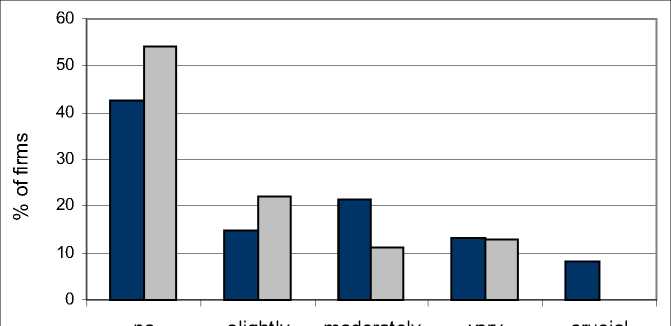19
the traditional industrial firms in the sample show that the percent of the innovative firms in
the periphery are 51% in contrast to only 31% among the firms in the metropolitan area. This
is based on the large extent of the traditional industrial firms located in the northern periphery
of Israel, who belong to the kibbutz sector. This sector had the willingness and the capability
to allocate more financial resources to R&D, than did the private sector, thereby increase the
technological level of traditional industrial firms owned by the Kibbutz sector. This fact
apparently contribute to the high ranking of this barrier by the industrial traditional firms
located in the peripheral zone against those that located in the metropolitan area. On the other
hand the complexity of creating innovation in the hi-tech sector and the extremely importance
they ascribed to highly skilled labor cross regional boundaries. Therefore this regarded as
significant barrier to the development of innovation in the eyes of the hi-tech firms, without
any connection to their spatial location.
The second important barrier to the success of innovation is the lack of market consumption
to new products and processes. Here too the differences between the firms according to
location in the importance they regarded to this factor found to be statistically significant.
Traditional firms located in the metropolitan area ascribed much more significant to this
barrier than does the firms in the periphery as depict in Figure 6.
Among the firms located in the peripheral region, 54% indicated no significant at all and 22%
indicated only slightly significant to this barrier. On the other hand 43% of the firms located
in the metropolitan area indicated to this factor moderately significant importance or more.
This resultant probably from the specific structure of the traditional industry exists in the
Northern region of Israel, as described above. With their larger engagement in innovation
these firms located in the peripheral region based on new markets to their new products and
processes. Conversely the firms belong to this industrial sector and located in the central area,
focuses more on existing products and less on the development of new products. Therefore
their requirements to identify new market is less, than the innovative firms in the peripery.
Figure 6: Distribution of traditional industries (%) according to the importance they ascribed
to the lack of market consumption as a barrier to innovation, by regions

More intriguing information
1. Ex post analysis of the regional impacts of major infrastructure: the Channel Tunnel 10 years on.2. DISCUSSION: POLICY CONSIDERATIONS OF EMERGING INFORMATION TECHNOLOGIES
3. Text of a letter
4. The Role of Trait Emotional Intelligence (El) in the Workplace.
5. RETAIL SALES: DO THEY MEAN REDUCED EXPENDITURES? GERMAN GROCERY EVIDENCE
6. Non Linear Contracting and Endogenous Buyer Power between Manufacturers and Retailers: Empirical Evidence on Food Retailing in France
7. Do the Largest Firms Grow the Fastest? The Case of U.S. Dairies
8. The name is absent
9. Correlation Analysis of Financial Contagion: What One Should Know Before Running a Test
10. The name is absent